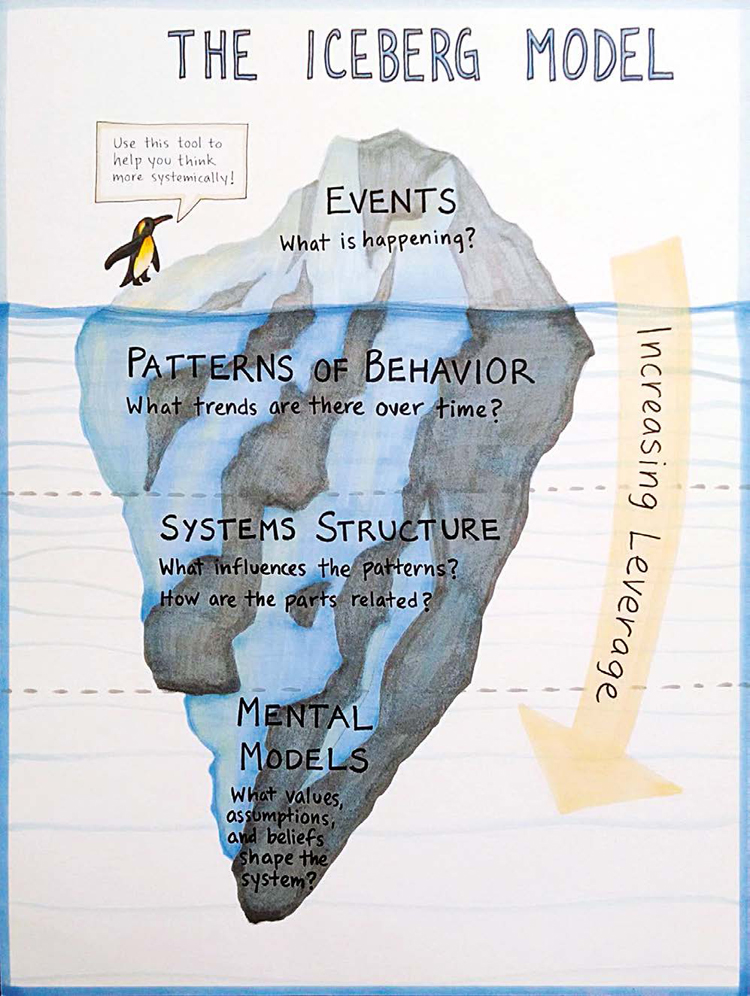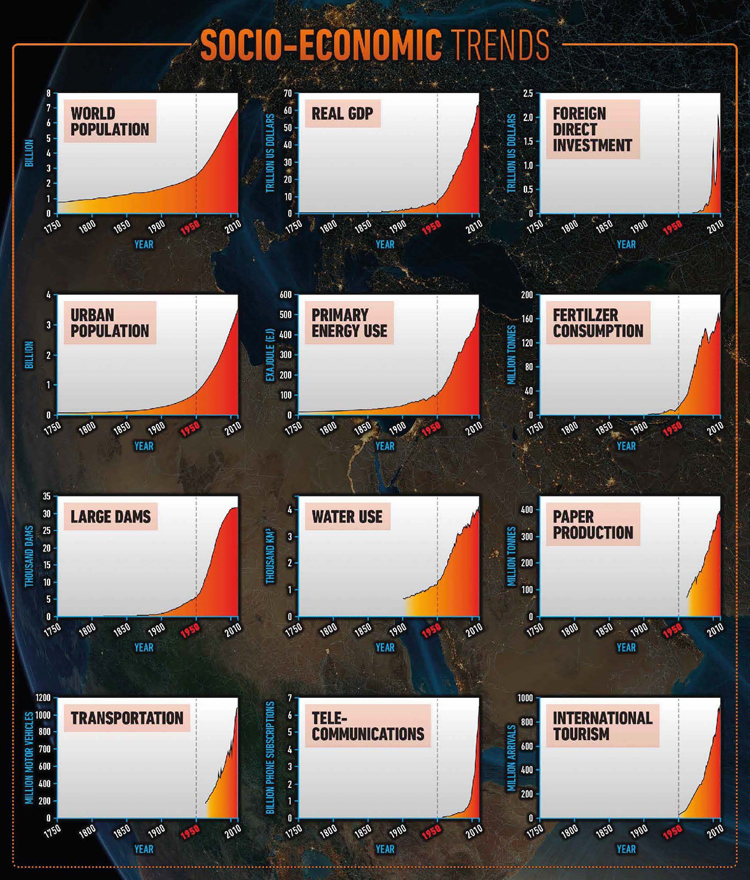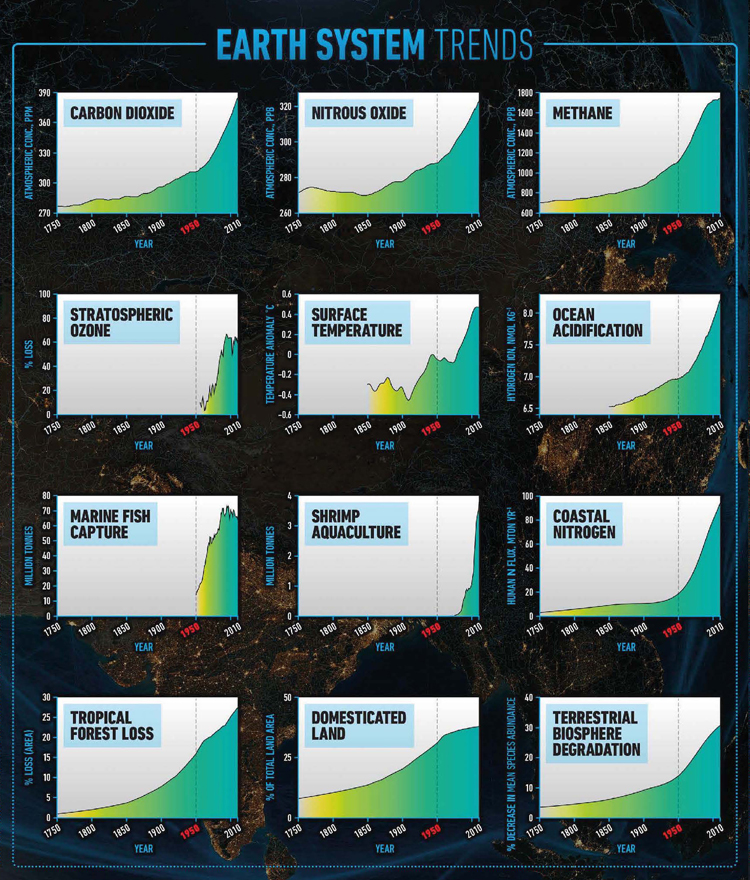Researchers at the Stockholm Resilience Center call it the “Great Acceleration”. It’s a surge that has been observed since the 1950s in the data of population, exploitation of resources, use of fertilizers, carbon pollution, fishery depletion, biodiversity loss, and more. Until the 1950s the effects of human activities were by comparison a small thing, almost undetectable.

“The Iceberg Model, inspired by Donella Meadows work is always a reminder for me to go beyond the tip in defining a problem and finding places for intervention.” Marta Ceroni. |
“In a single lifetime, humanity has become a planetary-scale geological force,” says Will Steffen, who led the study in collaboration with the International Geosphere-Biosphere Programme.
Meanwhile, the International Commission on Stratigraphy is evaluating whether to add the Anthropocene as a geological epoch, which could officially end up next to the Holocene and Pleistocene in schoolbooks.
The Anthropocene is also a period of raised global awareness. It sees the birth of large social movements (Paul Hawken talks of at least one million of organizations invested in social change worldwide) and the beginnings of circular and bio-based economies. It is also an unprecedented time of convergence across borders as signaled by the climate accord in Paris, the launch of the UN’s Sustainable Development Goals, and the encyclical Laudato Si’ by Pope Francis.
At this special time of acceleration and supranational commitments to sustainability, the business world is increasingly reflecting on its role in society and redefining the boundaries of its social responsibility. A new consciousness is seeping through parts of the business community, questioning conventional bottomlines, leadership styles, workspaces, and the very fundamental belief of the necessity to grow endlessly (think of Patagonia’s campaign “Don’t Buy This Shirt”, which coincidentally brought a spike in sales).
In the meantime, floods, droughts, and social unrest linked to climate change is costing businesses dearly.
|
|
|
The Great Acceleration.
|
Unilever, the Anglo-Dutch multinational whose products enter the homes of two billion people, estimates that drought, reduced agricultural productivity and the consequent increase in food prices cost the company $400 million annually.
In the face of these “mega-challenges” many in the private sector are concerned that political commitments won’t be sufficient to ignite timely action. “Green consumption,” while on the rise, has failed to amount to a transformative force that could shape sustainable production.
Hence the need and the urgency felt by socially responsible companies for a more active and far-sighted role on the part of business. So what is the next big game for corporate social responsibility?
In his book, The Big Pivot, Andrew Winston recognizes that it is a unique moment for the private sector, the time to re-discuss worldviews and the very reason for a company to exist.
According to Winston the role of business should be that of tackling a problem and then use business ingenuity to make the solution profitable, as opposed to creating problems in the first place (e.g. epidemic in diabetes related – at least in part – to sugary beverages available on the market).
If business more and more sees itself as part of the solution, does it have the leadership, vision, and incentives, to take on this high-level problem solving?
A vast majority of public companies, especially in the US, still operate under strong pressure to maximize short-term profits. And despite efforts by an increasing number of companies to reduce their environmental footprints, only in a few cases these interventions reflect a systemic approach, influenced by an understanding of reality and of the extent of the necessary transformation.
Social entrepreneur and academic Henk Hadders, describes the challenge in this way: “We still build the same old institutions to solve new complex problems with the same old set of rules, driven by the same old culture with much the same old school managers and leaders in place.”
The pivotal moment is emerging as one in which the most successful companies will be those who won’t only manage to navigate through growing uncertainty but the ones who will open the doors to innovative models and turn daunting challenges like climate change into economic opportunities.
This is not an easy and charted course and calls for new leadership that is attuned to how complex systems operate, which is open to envisioning alternative futures, and is capable of building strength and vision from the base.
Peter Senge, Hal Hamilton and John Kania call this set of skills “system leadership” in their paper “The Dawn of System Leadership”. Three qualities stand out in systems leaders: the ability to see the whole system (instead of only its parts); the ability to facilitate authentic reflections; the ability to move from solving problems to co-create a different future.
Anyone who embarks on the path of personal growth and system leadership will encounter Donella “Dana” Meadows on the way, lead author in 1972 of Limits to Growth. The book is one of the best known (and accessible) systems analyses ever published, and focuses no less than on humanity’s fate as population, economy, and resource extraction continue to grow within our finite planet. The study was unjustly accused of catastrophism because it foresaw the collapse of human civilization sometime after 2020-2030 unless humanity slowed down the pace of economic growth and human population. In the twenty- and thirty year updates that followed, the authors confirm this worrisome direction and realize that data alone, however accurate and reproducible are not enough to shake political and economic will. High potential, according to Meadows, lies in cultivating human qualities that catalyze deep change, qualities such as visioning, the ability to create networks of people with common goals, the ability to create new flows of information and transparency, the ability to remain humble and open to learn, and finally the ability to love.
 |
|
Donella Meadows
|
Meadows devotes an entire book, Thinking in Systems, published posthumously in 2008, to these qualities and to the practical understanding of systems for change makers.
“As our world continues to change rapidly and become more complex, systems thinking will help us manage, adapt, and see the wide range of choices we have before us,” writes Meadows in Thinking in Systems.
Many of these choices have to do with recognizing the strength of leverage points in a system. “These are places within a complex system (a corporation, an economy, a living body, a city, an ecosystem) where a small shift in one thing can produce big changes in everything.”
One such point of leverage, and one that is most often ignored, is a system’s ultimate goal. Not to be confused with a system’s stated goal, this is what in the end the system produces as a result of its own workings. Because we are born into systems and we inherit them from the previous generation, we rarely ask what the purpose of a family, a school, a company, a monetary system or an economy is.
“If you define the goal of society as GDP” writes Meadows, “that society will do its best to produce GDP. It will not produce welfare, equity, justice or efficiency unless you define a goal and regularly measure and report the state of welfare, equity, justice, or efficiency.”
Explicit goals and their measurements are something that socially responsible companies have understood for a long time when choosing a triple bottom line approach. But there’s something particularly transformational, from a systems perspective, in making it easier for companies to pursue alternative bottom lines.
Thirty US states have passed laws that allow the formation of “Benefit Corporations”, companies that are not required to maximize profits and can decide to reinvest in community and the environment without the risks of being opposed or slowed down by shareholders. At the moment it is estimated that there are 1,400 benefit corporations in 42 states, all committed to redefine the boundaries of their success and their social responsibility.
Another lever for change that Meadows puts high in the list of interventions, are the rules of a system. “If you want to understand the deepest malfunctions of systems, pay attention to the rules, and to who has power over them,” writes Meadows. One rule companies are starting to advocate far more intentionally for than in the past is a price on carbon. And one thing is seeing Ben & Jerry’s, the ultra-progressive Vermont ice cream company, doing this type of advocacy, another thing is seeing six large oil companies – BP Plc, Royal Dutch Shell Plc, Total SA, Statoil ASA, Eni SpA and BG Group – writing Christiana Figueres, Executive Secretary of the UN Framework Convention on Climate Change, demanding a price on carbon. Exxon Mobile, by hiding its own information from the public and spending millions to promote misinformation, was misusing another highly important leverage point. Meadows describes the critical role of information flows as following: “If I could, I would add an Eleventh Commandment: Thou shalt not distort, delay, or sequester information. You can drive a system crazy by muddying its information streams. You can make a system work better with surprising ease if you can give it more timely, more accurate, more complete information.”
Places to Intervene in a System
(in increasing order of effectiveness)
12. Constants, parameters, numbers (such as subsidies, taxes, standards).
11. The sizes of buffers and other stabilizing stocks, relative to their flows.
10. The structure of material stocks and flows (such as transport networks, population age structures).
9. The lengths of delays, relative to the rate of system change.
8. The strength of negative feedback loops, relative to the impacts they are trying to correct against.
7. The gain around driving positive feedback loops.
6. The structure of information flows (who does and does not have access to information).
5. The rules of the system (such as incentives, punishments, constraints).
4. The power to add, change, evolve, or self-organize system structure.
3. The goals of the system.
2. The mindset or paradigm out of which the system – its goals, structure, rules, delays, parameters – arises.
1. The power to transcend paradigms.
But the point of intervention that has the most potential to stir profound change, and also the hardest to move, is the mindset out of which the goals, rules and workings of a system arise.
Ray Anderson, the late CEO of Interface Carpet, the leading designer and maker of carpet tile, realized in 1994 that his company was nothing but the direct extension of the petrochemical industry and at sixty years of age decided to change course. In his book Mid-Course Correction he writes: “We have chosen Dana Meadows’ most difficult and most effective place to try to make a difference. The reinvention of Interface reflects the new and more accurate view of reality, a new mindset for a new industrial system. We are going about this reinvention ambitiously, aspiring to become the sustainable corporate model for the next industrial revolution.” This “new mindset,” which recognizes the finite capacity of ecosystems to absorb pollutants, which aspires to the long term and accounts for environmental costs, brought the 5,000 employee company to a complete transformation of its production and supply chain, and to being well on route to carbon neutrality in 2020.
But Meadows reminds us that the “new mindset” is also one of embracing complexity at a deep level and letting go of the notion that, once we bring them down to their bare bone elements, systems can be predicted and controlled. “We can’t impose our will upon a system. We can listen to what the system tells us, and discover how its properties and our values can work together to bring forth something much better than could ever be produced by our will alone.”
Ultimately, in an accelerating world and on the way to leading big in corporate social responsibility, the question won’t be so much how does business become part of the solution, but how does business reorganize itself to be a vehicle for system change.
Donella Meadows Institute, www.donellameadows.org
Stockholm Resilience Center, www.stockholmresilience.org
International Geosphere-Biosphere Programme, www.igbp.net





